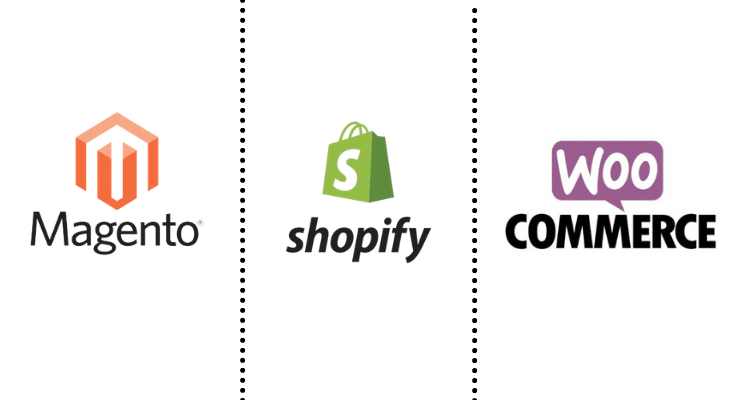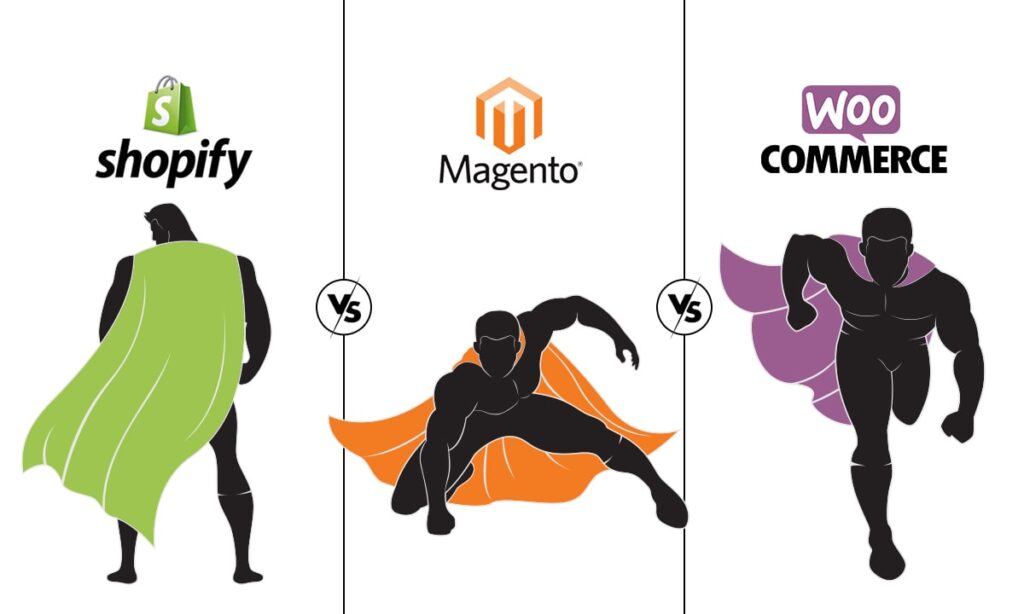You’re probably drowning in a sea of e-commerce platforms, with hundreds of options screaming for your attention. But let’s cut to the chase – when it comes to the crème de la crème, woocommerce vs shopify vs magento are the top three platforms that genuinely matter. Each has its unique strengths, from WooCommerce’s flexibility to Shopify’s scalability and Magento’s advanced resource allocation features. But which one is right for your business? Do you go for the free plugin, the cloud-based infrastructure, or the large-scale business solution? That’s a question we’ll explore next, as we compare Woocommerce Vs Shopify Vs Magento.
Key Takeaways
- WooCommerce is a free plugin, ideal for small businesses, but requires WordPress site and hosting with extensions and themes available for purchase.
- Shopify offers a seamless user experience, customizable templates, and a streamlined checkout process with a monthly subscription ($29-$299).
- Magento provides advanced features like multi-server setups and load balancing, ideal for large-scale businesses, with a custom quote required for its Enterprise Edition.
- Shopify and Magento offer scalable and cloud-based infrastructure, while WooCommerce relies on WordPress site and hosting scalability.
- Key features comparison shows that Shopify excels in user experience, Magento in scalability, and WooCommerce in pricing flexibility and customization.
Key Features Comparison

When comparing e-commerce platforms, one of the most critical aspects to consider is their key features.
You’ll want to evaluate how each platform’s features align with your business needs and goals.
A user experience that’s seamless and intuitive is crucial for driving sales and customer satisfaction.
You should look for platforms that offer customizable templates, drag-and-drop page builders, and mobile-responsive designs.
Consider the checkout process, too – it should be streamlined and secure to reduce cart abandonment rates.
Payment gateways are another vital feature to consider.
You’ll want to ensure that the platform you choose supports the payment methods you need, such as credit cards, PayPal, or Apple Pay.
Some platforms also offer built-in payment gateways, which can simplify the payment process and reduce transaction fees.
Additionally, you should consider the platform’s inventory management, shipping integrations, and product variations features.
These features can help you manage your online store efficiently and provide a better experience for your customers.
Scalability and Performance
As you’ve evaluated an e-commerce platform’s key features to ensure they align with your business needs, you’ll also want to consider how well the platform will scale with your growth.
When it comes to scalability and performance, you need a platform that can efficiently handle increased traffic, sales, and data storage.
In terms of load handling, Shopify and Magento have robust architecture that can handle large volumes of traffic and sales.
Shopify’s cloud-based infrastructure automatically scales to meet demand, while Magento’s built-in caching and content delivery network (CDN) ensure fast page loads.
Woocommerce, on the other hand, relies on your WordPress hosting provider to handle increased traffic.
Effective resource allocation is also crucial for scalability and performance.
Magento offers advanced resource allocation features, such as multi-server setups and load balancing, to ensure optimal performance.
Shopify’s cloud-based infrastructure also allocates resources dynamically to ensure seamless performance.
Woocommerce requires more manual configuration to optimize resource allocation.
Pricing and Customization

The cost of an e-commerce platform can significantly impact your business’s bottom line, so it’s essential to evaluate the pricing models of various platforms before making a decision. WooCommerce, Shopify, and Magento offer different pricing models that cater to different business needs.
| Platform | Pricing Model |
|---|---|
| WooCommerce | Free plugin, but requires a WordPress site and hosting, with extensions and themes available for purchase |
| Shopify | Monthly subscription ($29-$299) with additional fees for payment gateways and third-party apps |
| Magento | Community Edition is free, but Enterprise Edition requires a custom quote, with additional costs for hosting, themes, and extensions |
When it comes to customization, all three platforms offer theme integration and customization options. WooCommerce and Magento allow for more flexibility in terms of payment gateways, with WooCommerce supporting over 140 payment gateways and Magento supporting multiple payment gateways through extensions. Shopify, on the other hand, has a more streamlined payment process, but with limited customization options. Ultimately, the choice between these platforms depends on your business needs and budget.
FAQs: Woocommerce Vs Shopify Vs Magento
What Is the Learning Curve for Each Platform?
When setting up an e-commerce site, you’ll face a learning curve with each platform. Your e-commerce onboarding experience will be smoother if you have platform familiarity, allowing you to quickly grasp Woocommerce, Shopify, or Magento’s unique features.
Are There Mobile Apps for Store Management?
You’re probably glued to your phone, so it’s ironic that you’re wondering if store management apps exist. Yes, they do. You’ll get app notifications and can do remote monitoring with Shopify, Woocommerce, and Magento mobile apps.
Can I Migrate From One Platform to Another?
When migrating, you’ll need to consider platform compatibility. You can use data migration tools to simplify the process, but be prepared for potential hurdles and manual adjustments to ensure a smooth transition.
Do I Need Coding Skills to Customize Templates?
You’ll be overwhelmed by endless design possibilities, but to truly unlock template flexibility, you’ll need coding skills to overcome design limitations, as out-of-the-box templates often lack customization options.
Are There Built-In Security and Backup Features?
When setting up an e-commerce site, you’ll want robust security protocols in place. Look for platforms with built-in data encryption, firewalls, and automatic backups to safeguard customer info and protect against potential data breaches and losses.
Conclusion
You’ve weighed the wonders of WooCommerce, Shopify, and Magento. Each platform’s prowess presents a unique path to e-commerce success. WooCommerce woos with flexibility, Shopify shines with scalability, and Magento masters resource allocation. By pinpointing your business priorities, you’ll pick the perfect platform to propel your online store to prosperity. Prioritize performance, pricing, and customization to precision-craft your e-commerce empire.
